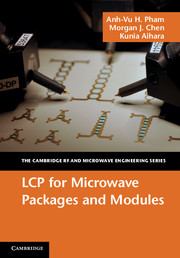Book contents
- Frontmatter
- Contents
- Preface
- 1 Introduction to electronic package engineering
- 2 Characteristics of liquid crystal polymer (LCP)
- 3 Fabrication techniques for processing LCP
- 4 LCP for wafer-level chip-scale MEMS
- 5 LCP for surface mount interconnects, packages, and modules
- 6 LCP for passive components
- 7 LCP for system design
- 8 LCP reliability
- Abbreviations, acronyms, and symbols
- Index
- References
2 - Characteristics of liquid crystal polymer (LCP)
Published online by Cambridge University Press: 05 July 2012
- Frontmatter
- Contents
- Preface
- 1 Introduction to electronic package engineering
- 2 Characteristics of liquid crystal polymer (LCP)
- 3 Fabrication techniques for processing LCP
- 4 LCP for wafer-level chip-scale MEMS
- 5 LCP for surface mount interconnects, packages, and modules
- 6 LCP for passive components
- 7 LCP for system design
- 8 LCP reliability
- Abbreviations, acronyms, and symbols
- Index
- References
Summary
Liquid crystal polymer (LCP) has interesting characteristics that have garnered the attention of RF and microwave circuit designers. One major difference from typical high-frequency materials is that LCP is a thermoplastic. With LCP’s advent, engineers have discovered how to integrate high-performance electronics directly into the thermoplastic package. The reason why LCP is attractive for RF/microwave electrical design is its unique combination of excellent electrical and mechanical properties. LCP is extremely stable in the presence of moisture and exhibits near-hermetic properties. Given its relatively low cost, LCP is rapidly becoming the material of choice for new generations of electronics requiring increasing integration and performance. This makes LCP a serious candidate for multi-chip module (MCM), system-in-package (SiP), and advanced packaging technology.
In section 2.1, we will first discuss LCP’s chemical properties. The basic chemistry will be introduced, and LCP’s composition will be described and discussed. This section is presented from an application stance and is intended to provide a brief working background to why LCP behaves as it does.
In section 2.2 we describe LCP’s electrical properties. LCP has been characterized as having a very low dielectric constant and loss factor over the frequency range from below 1 GHz up to past 110 GHz [2]. Its low dielectric constant allows reasonable line impedances to be formed on thin-film material and, further, minimizes the impact on the nearby electronics as well as the capacitive detuning effects of packaging. Methods for electrical characterization and study results are presented. The test results of LCP in moisture are also provided, to demonstrate its stable electrical characteristics over humidity changes.
- Type
- Chapter
- Information
- LCP for Microwave Packages and Modules , pp. 16 - 40Publisher: Cambridge University PressPrint publication year: 2012
References
- 1
- Cited by



